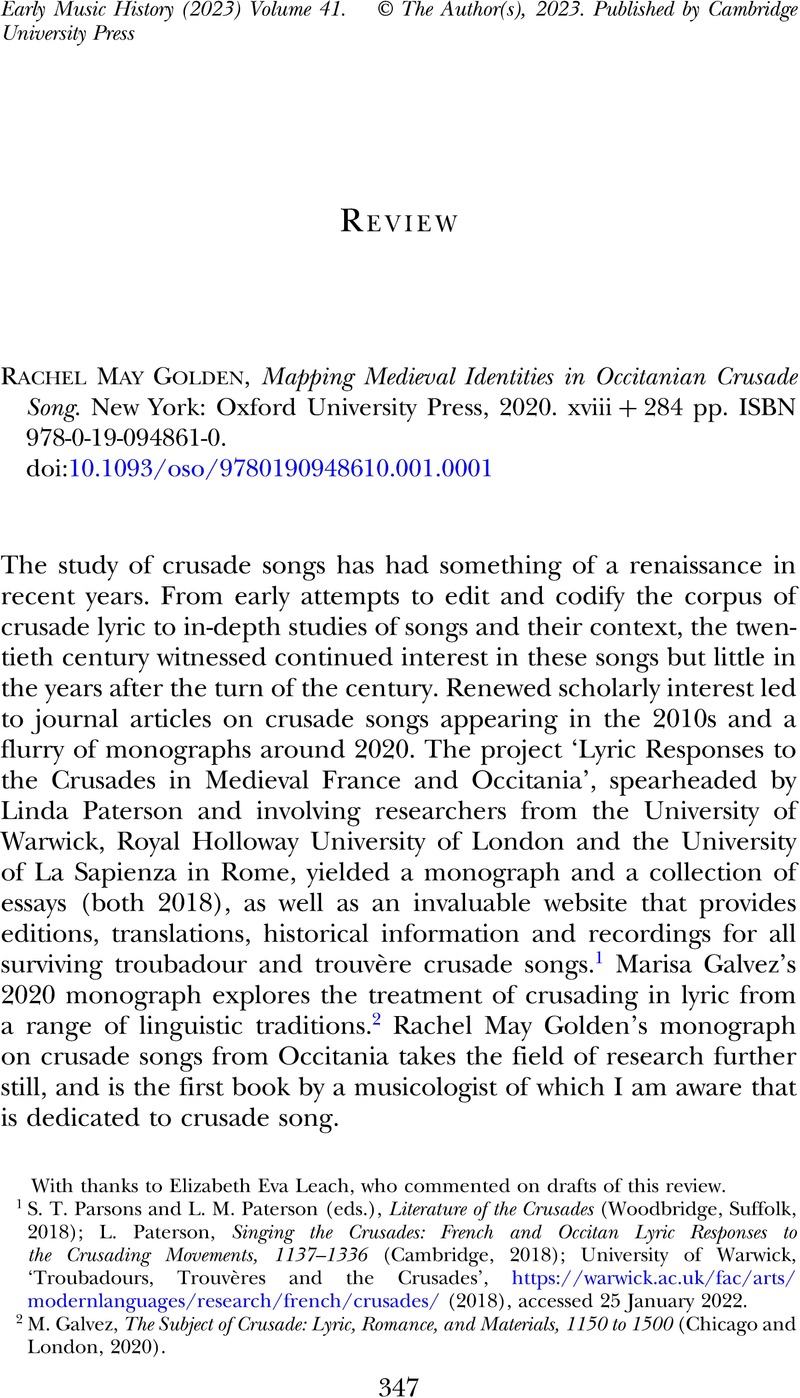No CrossRef data available.
Published online by Cambridge University Press: 20 October 2023

With thanks to Elizabeth Eva Leach, who commented on drafts of this review.
1 S. T. Parsons and L. M. Paterson (eds.), Literature of the Crusades (Woodbridge, Suffolk, 2018); L. Paterson, Singing the Crusades: French and Occitan Lyric Responses to the Crusading Movements, 1137–1336 (Cambridge, 2018); University of Warwick, ‘Troubadours, Trouvères and the Crusades’, https://warwick.ac.uk/fac/arts/modernlanguages/research/french/crusades/ (2018), accessed 25 January 2022.
2 M. Galvez, The Subject of Crusade: Lyric, Romance, and Materials, 1150 to 1500 (Chicago and London, 2020).
3 J. Bédier and P. Aubry, Les chansons de croisade (Paris, 1909), p. ix.
4 Troubadour songs are identified by their PC number according to A. Pillet and H. Carstens, Bibliographie der Troubadours (Halle (Saale), 1933).
5 S. Rankin, ‘On the Treatment of Pitch in Early Music Writing’, Early Music History, 30 (2011), pp. 105–75, at pp. 109–10. For examples from the ninth century, see C. M. Atkinson, The Critical Nexus: Tone-system, Mode, and Notation in Early Medieval Music (New York, 2009), pp. 66–7. See also M.-E. Duchez, ‘La représentation spatio-verticale du caractère musical grave-aigu et l’élaboration de la notion de hauteur de son dans la conscience musicale occidentale’, Acta musicologica, 51 (1979), pp. 54–73.
6 K. Berger, ‘The Hand and the Art of Memory’, Musica disciplina, 35 (1981), pp. 87–120, at pp. 90–3.
7 Andrew Hughes, ‘Solmization’, Oxford Music Online (2001), https://doi.org/10.1093/gmo/9781561592630.article.26154, accessed 26 January 2022, notes that the hand appears, with attribution to Guido, in the 12th century. For another type of spatial pitch placement on the hand in the 12th century, see A. M. Busse Berger, Medieval Music and the Art of Memory (Berkeley and London, 2005), pp. 74–5.
8 Ibid., pp. 91–4. For a discussion of a locational paradigm for memory, see M. Carruthers, The Book of Memory: A Study of Memory in Medieval Culture (Cambridge, 1990), passim.
9 M. Carruthers, ‘The Concept of Ductus, or Journeying through a Work of Art’, in M. Carruthers (ed.), Rhetoric Beyond Words: Delight and Persuasion in the Middle Ages (Cambridge, 2010), pp. 190–215.
10 T. B. Payne,‘Vetus abit littera: From the Old to the New Law in the Parisian Conductus’, in G. Bevilacqua and T. B. Payne (eds.), Ars Antiqua, Music and Culture in Europe c. 1150–1330 (Turnhout, 2020), pp. 163–204, at p. 186; J. W. Mason, ‘Trouver et partir: The Meaning of Structure in the Old French Jeu-parti’, Early Music History, 40 (2021), pp. 207–51, at pp. 229–39.
11 I set out this analytic approach to medieval song in J. W. Mason, ‘Structure and Process in the Old French Jeu-parti’, Music Analysis, 38 (2019), pp. 47–79, at pp. 65–71.
12 E. Aubrey, The Music of the Troubadours (Bloomington, 1996), p. 87.
13 The text for Ex. 2 is taken from S. N. Rosenberg, M. Switten and G. Le Vot (eds.), Songs of the Troubadours and Trouvères: An Anthology of Poems and Melodies (New York and London, 1998), p. 51. The melody is transcribed from Paris, Bibliothèque nationale de France, fr. 844, fol. 194v (troubadour MS W).